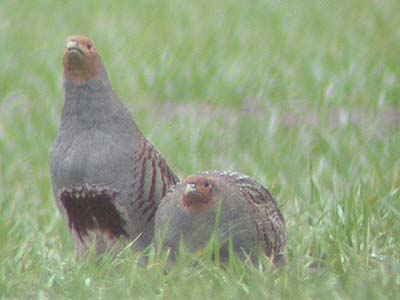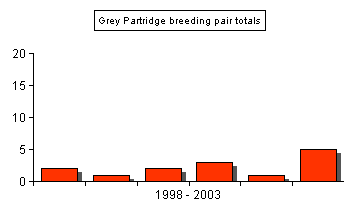

| Grey Partridge numbers rise 2003 | ||
| 2003 saw the continuing revival of several threatened farmland birds. Much has been written about the struggle of many of our native farmland species on this website before, but not all of it has been about how these species appear to be making a comeback in the area. | ||
| .... | ||
| In a situation similar to
that of that of the Tree Sparrow, numbers of Grey
Partridge have shown a substantial increase in resident
wintering populations during the last two years. What's
more, the number of breeding Grey Partridge in the area,
has also shown a small increase. Currently (2003-2004) the area's wintering Grey Partridge population ranges from 17-20+ birds, but they are often surprisingly difficult to locate during periods outside the breeding season. In the late 1990's, accumulated area counts only reached double figures on one occasion and coveys totalling more than seven birds were rare. This rise has not originated from birds being released by private estates for shooting purposes; a popular theory held by some when large numbers of Quail appeared around Eakring Field Farm a few years ago. |
 |
|
| .... | ||
| The Kingston Estate only rears and releases Pheasant into the area around Hare Hill Wood and Grey Partridge are almost unknown from there, since coverage in the area commenced in 1998. Instead (as with the Tree Sparrow) it comes as a direct result of the introduction of set-aside strips. Set-aside strips have provided safe areas for nesting birds, more favourable nesting sites and cover for newly-fledged young. Whereas (through their more temporary existance) the potentially high value which was created through the instigation of traditional set-aside fields is never really achieved - set-aside strips are permanent. | ||
| .... | ||
|
Many field-edges are now no longer
cultivated or sprayed with herbicides to the field boundary. Mechanical
disturbance is now more commonly associated with hedge-trimming from
July onwards, rather than through annual crop cultivation procedures. Breeding pair counts 1998-2003 Coveys of Grey Partridge do cover large areas during the Autumn/Winter months, with the pre-breeding dispersal beginning early in the year. Males have set up territories at favoured sites year after year and these are widely spaced through lack of competition from other Grey Partridges. Red-legged Partridges do offer some competition, but their numbers are held in check through shooting. Despite this, they are still more regularly encountered in the field. |
 |
|
| .... | ||
| The table above shows the scarcity of Grey Partridge in the area since 1998. Although numbers do remain extremely low, there were distinct signs during 2003 that a comeback is likely over the next few years, after five pairs were found to be breeding. | ||